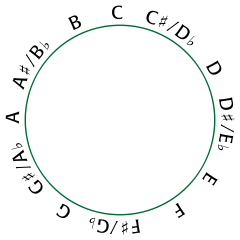
Short musical piece that uses the chromatic scale in the beginning as well as in the distorted part at 0:35

Chromatic scale drawn as a
circle: each note is equidistant from its neighbors, separated by a semitone of the same size
The chromatic scale is a musical scale with twelve pitches, each a semitone above or below another. On a modern piano or other equal-tempered instrument, all the semitones have the same size (100 cents). In other words, the notes of an equal-tempered chromatic scale are equally spaced. An equal-tempered chromatic scale is a nondiatonic scale having no tonic because of the symmetry of its equally spaced notes.[1]

Chromatic scale on C: full octave ascending and descending
 Play in equal temperament
Play in equal temperament or
 Play in Pythagorean tuning
Play in Pythagorean tuning The most common conception of the chromatic scale before the 13th century was the Pythagorean chromatic scale. Due to a different tuning technique, the twelve semitones in this scale have two slightly different sizes. Thus, the scale is not perfectly symmetric. Many other tuning systems, developed in the ensuing centuries, share a similar asymmetry. Equally spaced pitches are provided only by equal temperament tuning systems, which are widely used in contemporary music.
The term chromatic derives from the Greek word chroma, meaning color. Chromatic notes are traditionally understood as harmonically inessential embellishments, shadings, or inflections of diatonic notes.
Notation
The chromatic scale may be notated in a variety of ways.
Ascending and descending:[1]




The chromatic scale has no set spelling agreed upon by all. Its spelling is, however, often dependent upon major or minor key signatures and whether the scale is ascending or descending. The images above, therefore, are only examples of chromatic scale notations. As an abstract theoretical entity (that is, outside a particular musical context), the chromatic scale is usually notated such that no scale degree is used more than twice in succession (for instance G flat - G natural - G sharp).
Non-Western cultures
- The ancient Chinese chromatic scale is called Shí-èr-lǜ. However, "it should not be imagined that this gamut ever functioned as a scale, and it is erroneous to refer to the 'Chinese chromatic scale', as some Western writers have done. The series of twelve notes known as the twelve lü were simply a series of fundamental notes from which scales could be constructed."[2]
- The Indian solfège, i.e. sargam, makes up the twelve notes of the chromatic scale with respective sharps and flats.
Total chromatic
The total chromatic (or aggregate[3]) is the set of all twelve pitch classes. An array is a succession of aggregates.[3] See also: Tone row.
Tuning
In 5-limit just intonation the chromatic scale is tuned as follows, with flats higher than their enharmonic sharps:
| C | C♯ | D♭ | D | D♯ | E♭ | E | F | F♯ | G♭ | G | G♯ | A♭ | A | A♯ | B♭ | B | C |
| 1 | 25/24 | 16/15 | 9/8 | 75/64 | 6/5 | 5/4 | 4/3 | 25/18 | 36/25 | 3/2 | 25/16 | 8/5 | 5/3 | 125/72 | 9/5 | 15/8 | 2 |
In Pythagorean tuning (3-limit just intonation) the chromatic scale is tuned as follows, with sharps higher than their enharmonic flats:
| C | D♭ | C♯ | D | E♭ | D♯ | E | F | G♭ | F♯ | G | A♭ | G♯ | A | B♭ | A♯ | B | C |
| 1 | 256/243 | 2187/2048 | 9/8 | 32/27 | 19683/16384 | 81/64 | 4/3 | 729/512 | 1024/729 | 3/2 | 128/81 | 6561/4096 | 27/16 | 59049/32768 | 16/9 | 243/128 | 2 |
See also
Sources
- 1 2 Benward & Saker (2003). Music: In Theory and Practice, Vol. I, p.47. Seventh Edition. ISBN 978-0-07-294262-0.
- ↑ Needham, Joseph (1962/2004). Science and Civilization in China, Vol. IV: Physics and Physical Technology, p.170-171. ISBN 978-0-521-05802-5.
- 1 2 Whittall, Arnold. 2008. The Cambridge Introduction to Serialism, p.271. New York: Cambridge University Press. ISBN 978-0-521-68200-8 (pbk).
External links
|
|---|
| | Main Western | |
|---|
| | Types | |
|---|
| | Name | |
|---|
| | Ethnic origin | |
|---|
| | Modes | |
|---|
| | Number of tones | |
|---|
|
Recommended Reading
- Hewitt, Michael. 2013. Musical Scales of the World. The Note Tree. ISBN 978-0957547001.



